Solar eclipse of April 19, 2004
| Solar eclipse of April 19, 2004 | |
|---|---|
 Map | |
| Type of eclipse | |
| Nature | Partial |
| Gamma | -1.1335 |
| Magnitude | 0.7367 |
| Maximum eclipse | |
| Coordinates | 61°36′S 44°18′E / 61.6°S 44.3°E |
| Times (UTC) | |
| Greatest eclipse | 13:35:05 |
| References | |
| Saros | 119 (65 of 71) |
| Catalog # (SE5000) | 9517 |
A partial solar eclipse took place on Monday, 19 April 2004. A solar eclipse occurs when the Moon passes between Earth and the Sun, thereby totally or partly obscuring the image of the Sun for a viewer on Earth. A partial solar eclipse occurs in the polar regions of the Earth when the center of the Moon's shadow misses the Earth. It was largely visible over the south Atlantic Ocean and north shores of Antarctica, most prominently the Antarctic Peninsula. The eclipse was deep enough to be seen from a large portion of southern Africa, with over 50% totality at Cape Town, South Africa approximately 4:10 PM. However, the eclipse remained visible to cities such as Harare, Maseru, Durban, and Bloemfontein, although to a much lesser extent.
The greatest eclipse of the Sun took place over a nigh inaccessible strip of ocean off the Antarctic coast; the maximum point displayed 73.5% totality, as compared to Cape Town's 51% totality.
Images
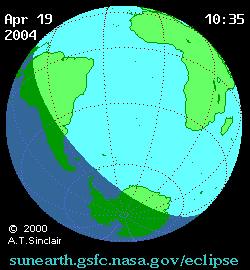
Animated eclipse path
Related eclipses
Solar eclipses 2004-2008
Each member in a semester series of solar eclipses repeats approximately every 177 days and 4 hours (a semester) at alternating nodes of the Moon's orbit.
| Ascending node | Descending node | |||
|---|---|---|---|---|
| Saros | Map | Saros | Map | |
| 119 | 2004 April 19 Partial (south) |
124 | 2004 October 14 Partial (north) | |
| 129 | 2005 April 8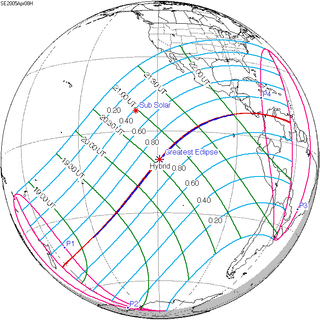 Hybrid |
134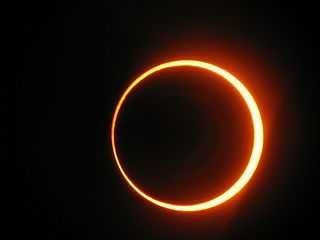 Annular from Spain |
2005 October 3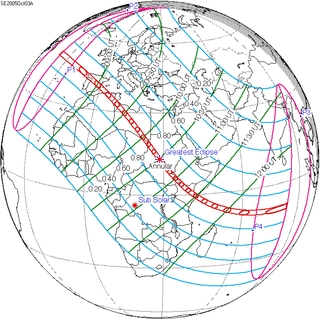 Annular | |
139 Totality from Side, Turkey |
2006 March 29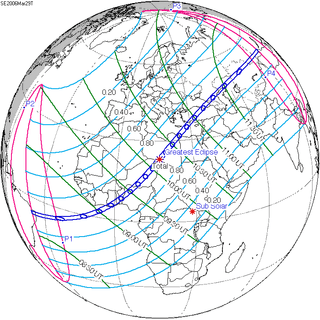 Total |
144.jpg) Partial from São Paulo, Brazil |
2006 September 22 Annular | |
| 149 | 2007 March 19 Partial (north) |
154 | 2007 September 11 Partial (south) | |
Metonic series
The metonic series repeats eclipses every 19 years (6939.69 days), lasting about 5 cycles. Eclipses occur in nearly the same calendar date. In addition the octon subseries repeats 1/5 of that or every 3.8 years (1387.94 days).
This series has 21 eclipse events, progressing from north to south between July 1, 2000 and July 1, 2076.
| July 1-2 | April 19-20 | February 5-7 | November 24-25 | September 12-13 |
|---|---|---|---|---|
| 117 | 119 | 121 | 123 | 125 |
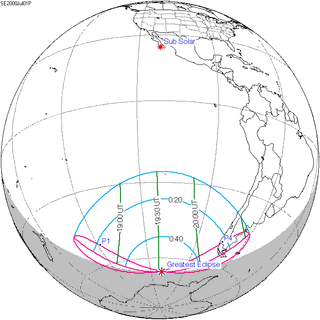 July 1, 2000 |
 April 19, 2004 |
 February 7, 2008 |
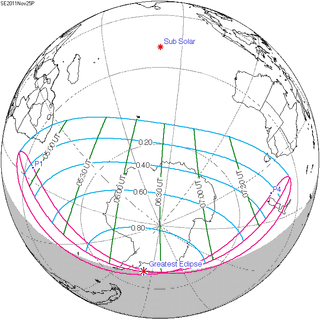 November 25, 2011 |
 September 13, 2015 |
| 127 | 129 | 131 | 133 | 135 |
 July 2, 2019 |
 April 20, 2023 |
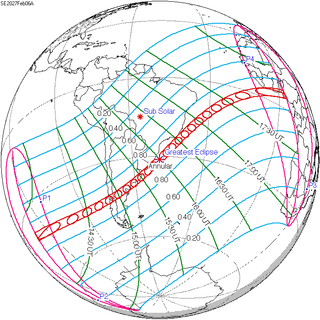 February 6, 2027 |
 November 25, 2030 |
 September 12, 2034 |
| 137 | 139 | 141 | 143 | 145 |
 July 2, 2038 |
 April 20, 2042 |
 February 5, 2046 |
 November 25, 2049 |
 September 12, 2053 |
| 147 | 149 | 151 | 153 | 155 |
 July 1, 2057 |
 April 20, 2061 |
 February 5, 2065 |
 November 24, 2068 |
 September 12, 2072 |
| 157 | ||||
 July 1, 2076 |
External links
- NASA Chart of the April 19 Solar Eclipse
- Science in Africa Document on April 19 Solar Eclipse, retrieved 2008-7-28
- Hybrid Eclipse of May 31: Future Eclipses, retrieved 2008-7-28

